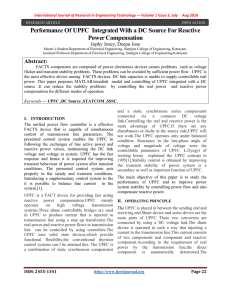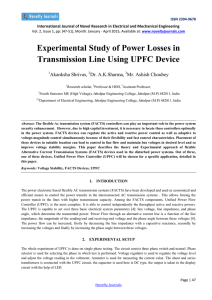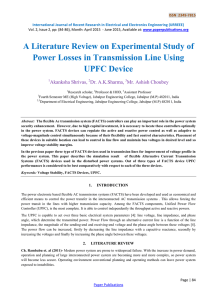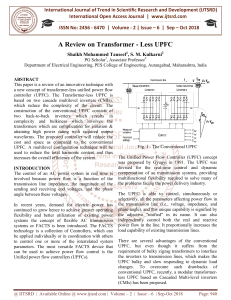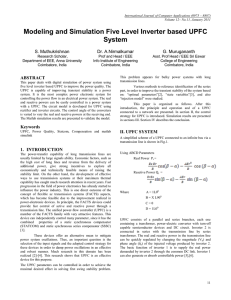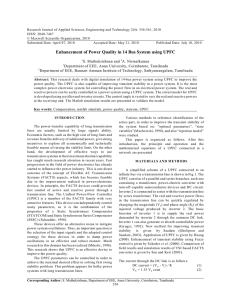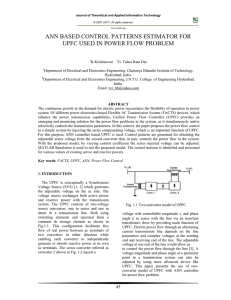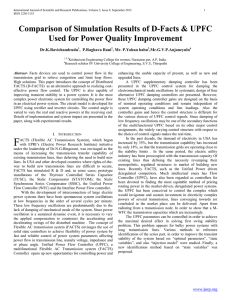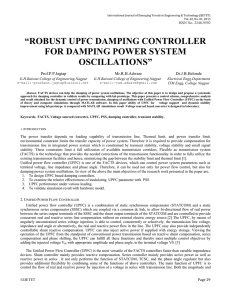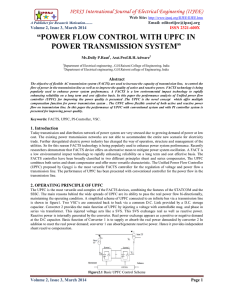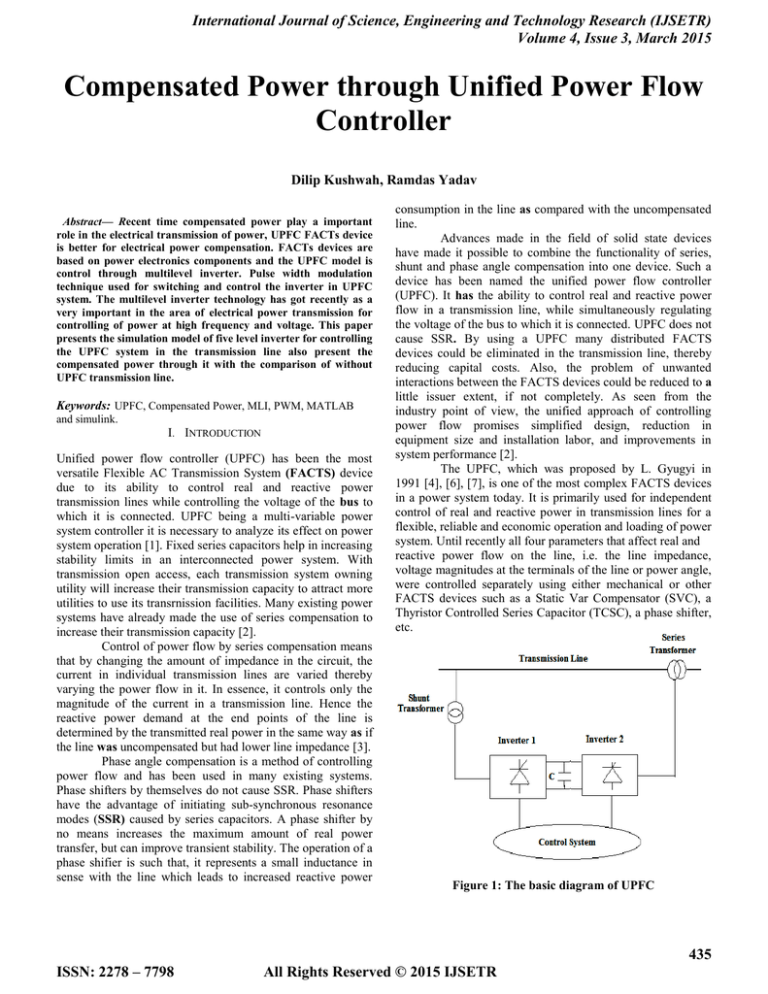
International Journal of Science, Engineering and Technology Research (IJSETR)
Volume 4, Issue 3, March 2015
Compensated Power through Unified Power Flow
Controller
Dilip Kushwah, Ramdas Yadav
Abstract— Recent time compensated power play a important
role in the electrical transmission of power, UPFC FACTs device
is better for electrical power compensation. FACTs devices are
based on power electronics components and the UPFC model is
control through multilevel inverter. Pulse width modulation
technique used for switching and control the inverter in UPFC
system. The multilevel inverter technology has got recently as a
very important in the area of electrical power transmission for
controlling of power at high frequency and voltage. This paper
presents the simulation model of five level inverter for controlling
the UPFC system in the transmission line also present the
compensated power through it with the comparison of without
UPFC transmission line.
Keywords: UPFC, Compensated Power, MLI, PWM, MATLAB
and simulink.
I. INTRODUCTION
Unified power flow controller (UPFC) has been the most
versatile Flexible AC Transmission System (FACTS) device
due to its ability to control real and reactive power
transmission lines while controlling the voltage of the bus to
which it is connected. UPFC being a multi-variable power
system controller it is necessary to analyze its effect on power
system operation [1]. Fixed series capacitors help in increasing
stability limits in an interconnected power system. With
transmission open access, each transmission system owning
utility will increase their transmission capacity to attract more
utilities to use its transrnission facilities. Many existing power
systems have already made the use of series compensation to
increase their transmission capacity [2].
Control of power flow by series compensation means
that by changing the amount of impedance in the circuit, the
current in individual transmission lines are varied thereby
varying the power flow in it. In essence, it controls only the
magnitude of the current in a transmission line. Hence the
reactive power demand at the end points of the line is
determined by the transmitted real power in the same way as if
the line was uncompensated but had lower line impedance [3].
Phase angle compensation is a method of controlling
power flow and has been used in many existing systems.
Phase shifters by themselves do not cause SSR. Phase shifters
have the advantage of initiating sub-synchronous resonance
modes (SSR) caused by series capacitors. A phase shifter by
no means increases the maximum amount of real power
transfer, but can improve transient stability. The operation of a
phase shifier is such that, it represents a small inductance in
sense with the line which leads to increased reactive power
consumption in the line as compared with the uncompensated
line.
Advances made in the field of solid state devices
have made it possible to combine the functionality of series,
shunt and phase angle compensation into one device. Such a
device has been named the unified power flow controller
(UPFC). It has the ability to control real and reactive power
flow in a transmission line, while simultaneously regulating
the voltage of the bus to which it is connected. UPFC does not
cause SSR. By using a UPFC many distributed FACTS
devices could be eliminated in the transmission line, thereby
reducing capital costs. Also, the problem of unwanted
interactions between the FACTS devices could be reduced to a
little issuer extent, if not completely. As seen from the
industry point of view, the unified approach of controlling
power flow promises simplified design, reduction in
equipment size and installation labor, and improvements in
system performance [2].
The UPFC, which was proposed by L. Gyugyi in
1991 [4], [6], [7], is one of the most complex FACTS devices
in a power system today. It is primarily used for independent
control of real and reactive power in transmission lines for a
flexible, reliable and economic operation and loading of power
system. Until recently all four parameters that affect real and
reactive power flow on the line, i.e. the line impedance,
voltage magnitudes at the terminals of the line or power angle,
were controlled separately using either mechanical or other
FACTS devices such as a Static Var Compensator (SVC), a
Thyristor Controlled Series Capacitor (TCSC), a phase shifter,
etc.
Figure 1: The basic diagram of UPFC
435
ISSN: 2278 – 7798
All Rights Reserved © 2015 IJSETR
International Journal of Science, Engineering and Technology Research (IJSETR)
Volume 4, Issue 3, March 2015
However, the UPFC allows simultaneous or independent
control of these parameters with transfer from one control
scheme to another in real time. Also, the UPFC can be used
for voltage support, transient stability improvement and
damping of low frequency power system oscillations. Because
of its attractive features, modeling and controlling an UPFC
have come into intensive investigation in the recent years.
technique for switching of MOFET, IGBT and also power
electronics switches.
III. SIMULATION ENVIRONMENT
The transmission line model is shown in figure 2.
II. UNIFIED POWER FLOW CONTROLLER
A. Constructional Details
A particular concept called Unified Power Flow
Controller is unified power flow in the transmission line. It is
a unique combination of shunt and series compensation and
power flow optimization. STATCOM (Static Synchronous
Compensator) and SSSC (Static Synchronous Series
Controller) are used for shunt and series combination
respectively shown in figure 1. The basic roll of the
STATCOM to flow active power demanded by the SSSC and
also supply or absorb reactive power. SSSC used for the
supply of active power in the line. Capacitor C is a DC link
that allows the flow active power between the output terminal
of SSSC and output terminal of STATCOM. Shunt
transformer used as a step down transformer and series
transformer as a step up.
B. Working Principal of UPFC
The main operation of inverters, inverter 1 connected
through the transmission line in series, with transformer and
inverter 2 in shunt with the transmission line through a second
transformer. The DC terminals of the inverter are connected
together with dc link capacitor.
In this model of UPFC, inverter 1 convert the AC to DC
and also the real power flows from the AC side to AC side
(inverter operation) if the inverter 2 output voltage is
controlled to increases the AC system voltage. If the converted
output voltage is made to decreases the AC system voltage the
real power will flow from the AC side to DC side (rectifier
operation). Inverter action is carried out by the MOSFETs
while the rectifier action is carried out by the diodes. Two
switches on the same leg cannot be on at the same time. The
magnitude of the inverter output voltage controls the reactive
power exchange between the converter and the AC system [5].
If the magnitude of the converter output voltage is greater
than the magnitude of the AC system voltage. If the magnitude
of the converter output voltage is less than that of the AC
system the converter will absorb reactive power. This all the
conditions made by the fluctuation of load side when load are
increases voltage level will be decreases but load are decreases
the over voltage condition will be occur at receiving end. Over
voltage and voltage drop can be controlled by the use of UPFC
in the transmission line.
Pulse Width Modulation technique used for this UPFC
controller because this technique is an old conventional
Figure 2: Single line diagram of transmission line
The line circuits model without UPFC system shown
in figure 2 that this line is also called as without compensated
line model. This circuit have 12 KV supply, R= 0.001*103Ω,
L=0.3*10 3*2 H With two RL load, one is connected and other
is disconnected from the supply through circuit breaker. The
designed UPFC system will be connect in the transmission
line model shown in figure 4.
UPFC consists of a parallel and series branches, each
one containing a transformer, power-electric converter with
turn-off capable semiconductor devices and DC circuit.
Inverter 2 is connected in series with the transmission line by
series transformer. Discrete RMS value component and active
reactive power block gives the result in the scope.
436
ISSN: 2278 – 7798
All Rights Reserved © 2015 IJSETR
International Journal of Science, Engineering and Technology Research (IJSETR)
Volume 4, Issue 3, March 2015
Table: Comparative result analysis at different voltage level
Input
in
KV
Active Power
(KW)
Without With
UPFC
UPFC
Improv
ed
in
(%)
Reactive Power
(KVAR)
Without With
UPFC
UPFC
Impro
ved
in
(%)
3
6
12
40
170
680
22.36
22.36
22.36
10.12
40.50
160.50
11.57
11.57
11.57
178.8
760
3040
87.50
350
1387
It can be seen that in the above table without and with
UPFC line model the value of active and reactive power from
the simulation results valuable changes that’s very important
for improvement of reactive power compensation.
Figure 3: Simulation model of Multilevel Inverter
IV. CONCLUSION
In the simulation study, matlab simulink enviroment
is used to simulate the model of Multi level inverter based
UPFC. This paper presents the control & performance of the
UPFC used for reactive power improvement. It is found that
there is an improvement in the real and reactive powers in the
transmission line when UPFC is introduced. The UPFC
system has the advantages like reduced harmonics and ability
to control real and reactive powers. The heating in the
transformer is reduced by using multilevel output. This is due
to the reduction in the harmonics from this effect improve the
power shown by table.
REFERENCES
[1]N.G.Higorani, "Flexible AC Transmission," IEEE
Spectnim, pp. 40-45, April 1993.
[2] D.N,Kosterev, W.A.Mittelstadt, R.R.Mohler, W.JKolodziej, "An Application study for sizing and rating
controlled and conventional senes compensation" IEEE
Transactions on Power Delivery, Vol. 1 1, No.2, pp. 11051111, April 1996.
[3] L-Gyugyi, " Unified power-flow concept for flexible ac
transmission systems,"IEE Proceedings-C, Vol. 139, No.4,
pp. 323-33 1, July 1992.
[4] [3] Higorani, N.G, Gyugyi,L., Understanding FACTS
Devices, IEEE Press 2000.
[5]M.H.Rashid, A text book of , Power Electronics Circuits,
Devices, and Application, Third
edition pp.414-417
Figure 4: Line model with UPFC
[6] Edris, A. Mehraban, A.S., Rahman, M., Gyugyi, L., Arabi,
S., Rietman, T.,'Cotnrolling the Flow of Real and Reactive
Power', IEEE Computer Application in Power, pp. 20-25
January 1998.
437
ISSN: 2278 – 7798
All Rights Reserved © 2015 IJSETR
International Journal of Science, Engineering and Technology Research (IJSETR)
Volume 4, Issue 3, March 2015
[7] Gyugyi, L., 'A Unified Power Flow Control Concept for
Flexible AC Transmission Systems', IEE Proceedings-C, Vol.
139, No. 4, pp. 323-331 July 1992.
Author Details:
1) Name: Dilip Kushwah
Education: M-Tech (Electrical Power System) from
Oriental University, Indore.
Job Details: Asst.Prof. in “Shri Dadaji Institute of
Technology & Science, Khandwa” (RGPV Bhopal
University) .
Research Area: Power Transmission Stability
2) Name: Ramdash Yadav
Education: ME (Power Electronics) from SATI
Vidisha
Job Details: Asst.Prof. in “Shri Dadaji Institute of
Technology & Science, Khandwa” (RGPV Bhopal
University) .
Research Area: Power Quality Improvement
438
ISSN: 2278 – 7798
All Rights Reserved © 2015 IJSETR

